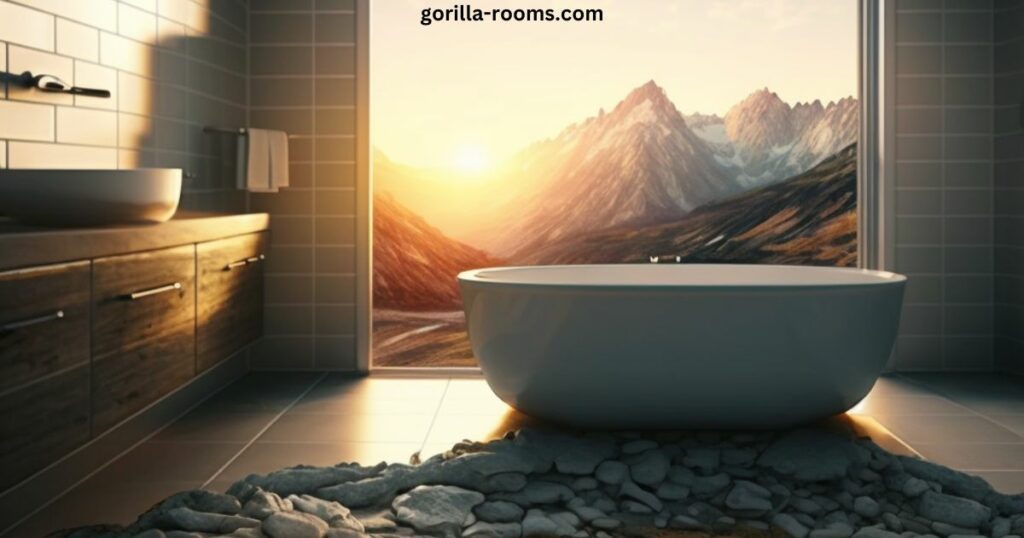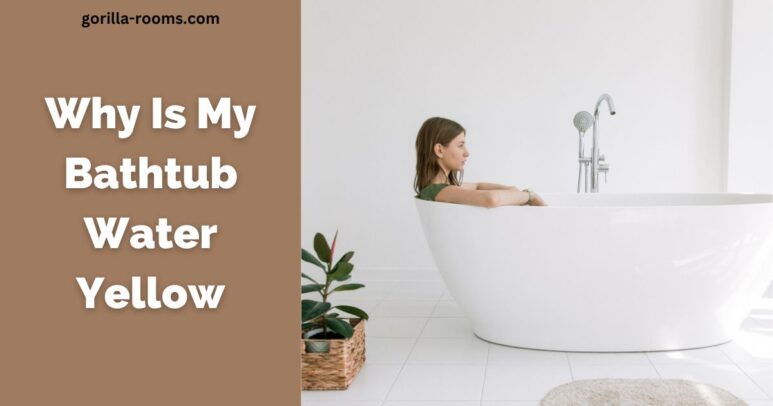Yellow water in the bathtub is frustrating and makes you not to take a bath. Also, the yellow water causes discoloration of the bathtub and leaves wired stains.
Your bathtub water can turn yellow for various reasons; understanding each is critical in determining which solution will work best for your specific tub. Corrosion, rust, sediment, or high levels of certain elements could all be to blame.
If you’re struggling with yellow water in your bathtub, you don’t need to worry about it. In this article, I have shared some quick fixes that will save you from this problem.
Why Is Bathtub Water Yellow and How to Fix It?

If you have noticed yellow water in your bathtub, there could be a couple of reasons for this.
Let’s look at the most common causes of this problem, along with diving into their solutions:
1- Rusty Pipes or Plumbing
Rust is the most common cause of your bathwater turning yellow. Pipes rust, which not only causes leaks and damage to your plumbing but also results in yellow water.
Small amounts of oxygen and iron are naturally present in water systems. When these amounts rise above average, the faucets’ water turns yellow.
Rust on the outside of a pipe is relatively easy to detect, but the real problem arises when your pipes rust from the inside out.
If this happens with all of your house’s faucets, it’s most likely a plumbing problem. To be specific, leave the water running for a while and see if it clears up.
How to fix Rusty Pipes?
First, determine which pipes are rusting. If your pipes are rusting from the inside out, this may be the most challenging part of the process.
Measure the pipes you want to replace and go to the store to buy new pipes and any connecting hardware. Shut off the main water supply.
Remove the rusted pipes and replace them with new ones using your plumber’s wrench. After your new pipes have been installed and tightened, reconnect your water supply and run your water. Inspect your plumbing for leaks and discolored water.
2- A Rusty Water Heater
Another cause of yellow bathtub water is water heater sediment, accumulating at the tank’s bottom over time. This is primarily due to rust and corrosion. This problem is easily detected by alternately running hot and cold water.
Remember to check more than one faucet throughout the house. If the cold water from the same faucet is fine, but the hot water is discolored, the problem is with the heater.
How to fix the Water Heater?
First, turn off your water heater altogether. Allow air to pass through your water heater by turning on a hot water faucet in your home.
Your tank has a drain outlet near the bottom. You may need to remove a cover with a ratchet and socket. Connect a standard household water hose to the drain outlet to drain the water and turn the valve.
Most of the rust or sediment will drain through the hose but add 5 or 6 gallons of cold water back into the water heater and drain it again.
Reassemble everything and turn it back on to test your water system and see if it solves your problem.
3- A Contaminated Water Supply
If the problem isn’t with your faucet, water heater, or plumbing, it must be with your water supply.
To determine the source of the problem, you may need to inspect your private well or contact the office of your local water district.
Certain minerals and contaminants, such as iron, manganese, lead, zinc, and copper, cause water to turn yellow in high concentrations.
How to fix a Contaminated Water Supply?
Using a water test kit, determine whether your private well is contaminated. If your well is contaminated, you can clean it yourself or hire a professional.
If your water is supplied from the city, contact your local water district and express your concerns. City water officials are usually very knowledgeable about the water they supply and can help you with any problems with your local city water.
4- High Levels of Chlorine in the Water
Hypochlorous acid is formed when chlorine is dissolved in water. This acid usually causes water to turn yellow, boiling water.
This is because hot water is more likely to turn into steam during a hot shower, causing chlorine to concentrate. As a result, hot tap water should have lower chlorine levels than cold water.
How to fix High Levels of Chlorine?
Installing a house filtration system reduces chlorine levels while also filtering out harmful bacteria. A UV radiation system is another viable option.
5- Faucet Rust
This is a more straightforward and more concise reason than the others. Sometimes your faucet becomes corroded from rust and sediment.
Over time, rust and other materials will accumulate in your faucet. Then, one day, you turn on your faucet, and the rushing water dislodges all of the accumulated materials, turning your water an unappealing yellow color.
How to fix a Rusted Faucet?
Replacing the rusted faucet is an immediate solution. Cut off the main water supply.
To remove the faucet’s cover and any handles that are attached to the cover, you’ll need a screwdriver. With the cover removed, you can see which tool is required to remove the faucet.
If your faucet is slightly corroded, remove the rust with a brush or soak it overnight in white vinegar. If your faucet is severely corroded, replacing it is usually more accessible and effective.
Is It Safe to take Bathe in Yellow Water?

When you turn on your hot water faucet and notice a yellowish tint, you may be concerned that your bathtub is unsafe to bathe in.
Most of the time, the yellow discoloration is caused by complex water salts left in the tub rather than being washed away with each shower or bath. While this may be dangerous in some cases, bathing in yellow bathwater is generally safe.
The minerals that turn the bathwater yellow could result from water heater corrosion or metal plumbing issues. If your bathtub is turning yellow more frequently than usual, you should have all of your plumbing checked for signs of corrosion.
While bathing in yellow water is usually safe, consult with a reputable local plumbing team first. They can conduct tests on your water supply to quickly identify the source of the problem and work with you to devise the best solutions to get your water running clear again.
Is Yellow Water Safe for Drinking?
Yellow water from the tap is usually safe, but you should avoid drinking it until you figure out what’s causing the discoloration.
While some yellow water is safe to drink, the discoloration may indicate an underlying issue. If your bathtub water occasionally turns yellow, you should be fine if it dissipates within a few minutes.
Because yellow water can be caused by aging, you should always thoroughly clean your bathtub after each use. This can be accomplished with a mild detergent free of chemicals and abrasives. To clean your tub, avoid using oven cleaner or rust remover, as these may cause more problems than they solve.
To be safe, drink bottled water and avoid cooking and washing with yellow water until you receive an assessment from a professional plumber who can conduct a water test.
How Do I Fix Black Stuff Coming Out of My Faucet?
When black water comes out of your faucet, it’s usually due to high magnesium content, deteriorating water softener resin beads, or flaking steel or galvanized plumbing.
Here’s how to fix it:
Magnesium
Magnesium is a mineral that is commonly found in tap water. When tap water is overly oxygenated, it can combine with magnesium, resulting in a black hue.
It is simple to determine whether this is the source of the problem: purchase a testing kit. Alternatively, hire a plumber to conduct a professional water supply test.
If magnesium and overly oxygenated water are the issues, installing a water softener is usually the best solution. You could buy a water filter, but water softeners are more effective.
Steel or Galvanized Plumbing
Consider plumbing throughout your home. What material is it made of? Is it true that the pipes are made of metal? If so, are the pipes steel or galvanized?
Inside the pipe, these materials can rust, allowing small rust particles to float freely in the water.
Other issues with the plumbing system, such as disintegrating rubber components, could also be to blame. Rubber in drinking water can harm your health, so it’s best to consult an experienced plumber for the best solution.
Broken Down Resin Beads
If you have a water softener, the black tint in your water could be due to the resin beads in the system. Water softeners require resin beads to function: these beads contain “soft ions,” An ion exchange occurs when the system passes hard water with “hard ions” over the beads. The hard water that enters the system softens due to this exchange.
These beads can be black in some cases. The beads may gradually degrade, eventually ending up in your water. Check your water softener system if you have a water softener and notice black water in your home. The problem can be solved by simply replacing the beads as needed.
Conclusion
Water turning yellow is not something to ignore, especially when it happens unexpectedly. This prompts you to search the internet for an answer to your question: Why is my bathtub water yellow?
Your bathtub water may turn yellow for a variety of reasons. It could be a plumbing, water source, water heater, or water treatment issue. Whatever the problem, there is always a solution.
Generally, if the problem is too complex for you to solve, you should always consult an expert. You can replace a showerhead or a faucet. When it comes to a more severe problem, however, no one can handle it better than a professional plumber.
FAQs
How do you fix yellow bath water?
The disturbance of naturally occurring sediment in the supply or particles from corroding, unlined iron pipes can cause straw-colored or yellow water. A sudden change in water’s direction or flow rate causes this disturbance.
What causes bath water to turn yellow?
This is usually caused by minerals in the water remaining in the tub instead of evaporating or draining with each bath or shower. The minerals bond to the tub’s surface and accumulate over time, turning it yellowish-brown. A rusted tub can also emit an unpleasant, pungent odor.

